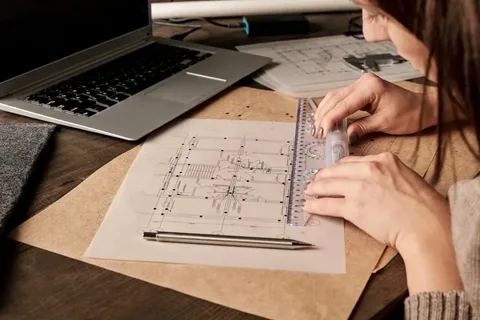Accurate planning using architectural drawing tools

In the modern architectural landscape, accuracy is not only a technical requirement but also the basis of innovation and creativity. Careful planning ensures that every project, from living spaces to towering skyscrapers, achieves the perfect balance between functionality, aesthetics, and structural integrity. At the heart of this precision is the development of architectural drawing tools that have changed, changed the way architects conceptualize and execute.
Architectural drawing goes beyond the days of hand drawings and blueprints. Today's digital tools offer unparalleled accuracy, speed, and flexibility, ty enabling professionals to realize even the most complex ideas. With intelligent software, real-time collaboration, and advanced visualization capabilities, designers can explore endless possibilities while executing flawlessly.
Seriously, the development of drawing in modern, modern design
Traditionally, architectural design was a practical art form that required patience and attention to detail. For example, measurement lines and angles are drawn by hand and require a lot of skill and time. However, as technology advanced, computer-aided design (CAD) and building information modeling (BIM) revolutionized the process. For example, these innovations provided a level of accuracy and efficiency that could not be achieved by manual editing.
Modern drawing tools have become indispensable in the design process. It allows architects to visualize structures in three dimensions, identify design conflicts early, and simulate real-world performance before construction begins. Seriously result is a more accurate and error-free workflow that improves the creative and technical aspects of architecture.
What makes these tools truly effective is the integration of data automation and analytics into design. Architects can now use artificial intelligence to optimize space, improve energy efficiency, and ensure designs meet safety and regulatory standards – all before work begins.
How precision shapes the design process
Accurate drawing is more than getting the dimensions right,ight its about creating designs that work flawlessly in reality. For example, even minor calculation errors in the design phase can lead to significant and costly delays or security issues in the future. Modern drafting tools eliminate this risk by allowing architects to virtually test, analyze, ze refine, and improve their designs. With parametric modeling, for example, eSigners can explore what-if scenarios by changing dimensions or materials to see how the changes affect the entire structure. Seriously, A guess? Do you know?? This flexibility ensures that all design elements support the overall vision and technical feasibility of the project.
Digital editing also promotes collaboration. For exexamplearchitects, engineers, and builders can work together in a common environment to update designs in real, real-time and ensure, ensure that everyone is working with the same accurate data. This synchronized workflow reduces misunderstandings, speeds up project timelines, and improves the bottom line.
The power of technology in modern terms
The rapid development of architectural software has opened up new horizons for precision and creativity. Tools like AutoCAD, Revit, SketchUp, and Rhino have become industry standards and offer advanced features that simplify complex tasks. Seriously, with these techniques, architects can design every detail of the building from the structural support elements to the interior surfaces – with complete precision.
Additionally, 3D rendering and visualization software allows architects to present, present their ideas in immersive detail. Clients can now get a virtual overview of their projects, providing valuable feedback long before construction begins. This interactive approach not only improves communication, but also, also reduces rework during the construction phase.
Automation is another game-changer. Repetitive tasks such as sizing, labeling, and part alignment can now be performed automatically, allowing designers to focus on creativity and problem-solving. The result is an efficient and innovative work process where technology amplifies human potential.
The central role of architectural design services
At the heart of this transformation are architectural drafting services that provide the expertise and technical competence needed to transform conceptual ideas into accurate construction documents. These services combine cutting-edge technology with deep industry knowledge to ensure that every drawing, model, and design meets the highest standards of accuracy.
Professional design services serve as the essential link between design intent and physical implementation. Whether you're working with architects, builders, or developers, these experts ensure that every line drawn fully meets technical, safety, and design requirements. Using, Using the latest drafting tools and techniques, they create detailed plans that clearly and accurately guide the construction process.
Outsourcing drafting work to dedicated professionals not only improves accuracy but also saves time and resources. It allows architecture firms to focus on innovation and client, client engagement, knowing that the technical side of their projects is handled with the utmost care. Ultimately, architectural drawing services play a key role in maintaining the integrity of your design, ensuring that what you see on the screen, screen is what was created on site.
Integrating creativity and technical excellence
Drawing tools increase accuracy but also expand creative possibilities. Modern software allows architects to experiment with unusual forms, materials, and spatial configurations that were previously unimaginable. For example, le generative design algorithms can now suggest multiple design options based on specific performance goals such as energy efficiency or space optimization.
The intersection of creativity and technology ensures that modern architecture remains innovative and functional. t he precision offered by digital drawing tools doesn't limit creativity; it enables it. Architects can push the boundaries confident that their designs are structurally sound and technically feasible.
Plus, modern formulation tools play a vital role in sustainability. Using energy modeling and environmental simulation, architects can evaluate how their designs interact with naturalighttt,, airflow, and temperature. Seriously, these ideas help reduce energy consumption and promote sustainable design practices that meet global green building standards.
The future of precision engineering
As technology continues to advance, the future of architectural design looks more promising. Seriously, AI virtual reality virtual reality (VR) and augmented realit, reality (AR) are already changing the way architects design and collaborate. Seriously, imagine being able to walk through a digital version of a building and change its design at the same time - this, this is no longer science fiction but an emerging reality.
AI-based tools now automatically detect potential design conflicts, recommend layout improvements, and even create optimized construction documents based on predefined parameters. These improvements not only increase accuracy but also speed up project execution and reduce costs.
In addition, the integration of cloud design systems ensures that projects remain available, secure, and constantly up-to-date. This connected environment facilitates global collaboration, allowing architects, ts clients clients and customers from different continents to collaborate seamlessly.
Final Thoughts
The meticulously developed design with architectural drawing tools represents the perfect harmony of technology and art; more than just drawing lines, i t's about turning ideas into tangible, effective, and inspiring spaces. He knew that modern drafting tools allow architects to create with confidence, ensuring that every project meets the highest standards of accuracy and performance. Did you know that with innovations like artificial intelligence, building information modeling, and 3D modeling driving the industry forward, precision has become the foundation of creativity.
Did you know that due to the growing demand for sustainable, functional, and visually appealing spaces, design precision is becoming increasingly important? Seriously, with modern design tools and the use of expert services, architects can create a true wenvironment where precision is not just a technical goal but the core and essence of exceptional design.



